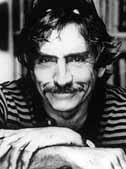| |

Edward Albee
(playwright;
born March 12, 1928, Washington, DC)
Edward Albee
burst onto the American theatrical scene in the late 1950s with a variety
of plays that detailed the agonies and disillusionment of that decade and
the transition from the placid Eisenhower years to the turbulent 1960s.
Albee's plays, with their intensity, their grappling with modern themes,
and their experiments in form, startled critics and audiences alike while
changing the landscape of American drama. He was unanimously hailed as
the successor to Arthur Miller, Tennessee Williams, and Eugene O'Neill.
Albee's 25 plays
form a body of work that is recognized as unique, uncompromising, controversial,
elliptical, and provocative. A canon that is, as Albee himself describes
it "an examination of the American Scene, an attack on the substitution
of artificial for real values in our society, a condemnation of complacency,
cruelty, and emasculation and vacuity, a stand against the fiction that
everything in this slipping land of ours is peachy-keen." No wonder, then,
that this forty-year career has seen as many commercial failures as successes.
The '80s, in fact did not yield a single Albee play that could be considered
a commercial hit. "There is not always a great relationship between popularity
and excellence," he says. "You just have to make the assumption you're
doing good work and go on doing it." Perseverance ultimately triumphed;
his most recent drama reclaimed Albee's position as America's leading dramatists.
Three Tall Women enjoyed a stunning, sold-out success in New York
and has been staged across the country and around the world. It received
Best Play awards from the New York Drama Critics Circle and Outer Critics
Circle and earned Albee his third Pulitzer Prize, an honor that is bested
only by Eugene O'Neill's four awards.
Born in Washington,
D.C., Albee was adopted as an infant by Reid Albee, the son of Edward Franklin
Albee of the powerful Keith-Albee vaudeville chain. He was brought up in
great affluence and sent to select preparatory and military schools. Almost
from the beginning he clashed with the strong-minded Mrs. Albee, rebelling
against her attempts to make him a success as well as a sportsman and a
member of the Larchmont, New York, social set. Instead, young Albee pursued
his interest in the arts, writing macabre and bitter stories and poetry,
while associating with artists and intellectuals considered objectionable
by Mrs. Albee.
Albee left home
when he was 20 and moved to New York's Greenwich Village, where he took
to the era's counterculture and avant-garde movements. After using up his
paternal grandmother's modest legacy, he took a variety of menial jobs
until 1959 when The Zoo Story made him a famous playwright, first
in Europe, where it premiered in Berlin, and then in New York. This short
work, in which a bum entices an executive to commit murder, together with
1962's full-length Who's Afraid of Virginia Woolf?, a brutal portrait
of a hard-drinking academic couple, and 1966's A Delicate Balance,
his first Pulitzer Prize-winner, created the mold for American drama for
the rest of our century.
Throughout his
career, Albee has shown a fascination for a wide variety of theatrical
styles and subjects. The Zoo Story conveyed the alienation and disillusionment
of the existentialist drama. In 1959, Albee explored American race relations
in the southern Gothic atmosphere of The Death of Bessie Smith.
He gave birth to American absurdist drama with The Sandbox (1959)
and The American Dream (1960). Who's Afraid of Virginia Woolf?
and A Delicate Balance are classic studies of American family life
in the mode of O'Neill's Long's Day's Journey into Night. 1964's
Tiny Alice is a metaphysical dream play in which Albee explores
his persistent theme of reality versus illusion, this time out in mystical,
abstract, and even religious terms. In 1975, Albee won his second Pulitzer
Prize with Seascape, which combined theatrical experiment and social
commentary in a story about a retired vacationing couple who meet a pair
of sea lizards at the beach. The Lady from Dubuque (1979) is a fable
in which the title character is none other than death.
Death, in fact,
has been a running character throughout his works. In spite of the wide
range in styles and subject matter, Albee has said that all his plays Òconfront
being alive and how to behave with the awareness of death. Every one of
my plays is an act of optimism, because I make the assumption that it is
possible to communicate with other people. The people who think Virginia
Woolf was a love story are a lot closer to the truth than those who
think it was a tragedy. At least there was communication in that marriage."
And like George and Martha, whose long night's journey finally ends in
day, Albee and his public have communicated with each other ever since
they met--through periods love and exhilaration, anger and neglect, truce
and reconciliation.
|

